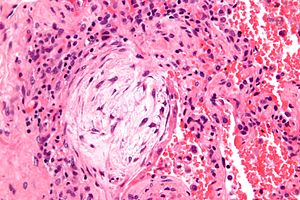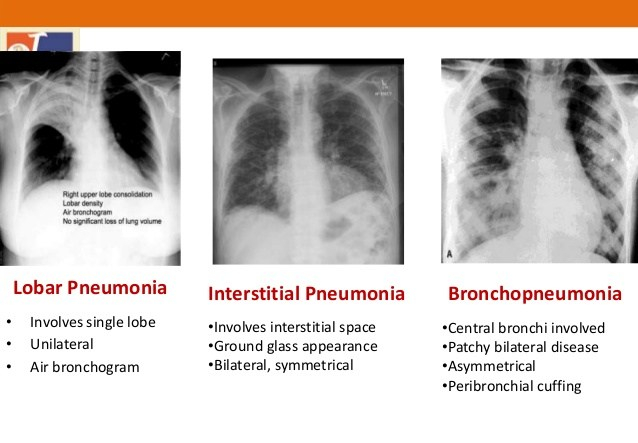Types
- Lobar
- may involve entire lobe or lung
- Bronchopneumonia
- patchy distribution involving ≥ 1 lobe involving bronchioles and alveoli
- Interstitial / Atypical pneumonia
- diffuse distribution involving ≥ 1 lobe involving interstitial areas
- Cryptogenic Organizing Pneumonia (COP) previously called B O O P
- noninfectious with unknown etiology / idiopathic
- ⊝ sputum and blood cultures, no response to antibiotics

Characteristics
Lobar
Intra-alveolar exudates cause consolidation
Bronchopneumonia
Acute inflammatory infiltrates from bronchioles into adjacent alveoli
Interstitial
- Diffuse patchy inflammation localized to interstitial areas at alveolar walls
- Indolent course
COP
- Variable dense chronic inflammation
- NO honeycomb change/fibrosis
- Alveolar architecture is usually preserved
- Loose aggregates of fibroblasts in ground substance (Masson bodies)

Microbial Associations
Lobar – S L K
- Strep. pneumonia
- MCC community-acquired lobar pneumonia
- middle- aged adults
- Legionella
- i/compromised
- intracellular
- transmitted via water source
- Klebsiella
- malnourished debilitated individuals
- elderly in nursing homes, alcoholics, and diabetics (enteric flora that is aspirated due to gastroparesis)
- thick mucoid capsule results in gelatinous sputum (currant jelly)
- often complicated by abscess
Bronchpneumonia
- S pneumoniae, Klebsiella
- H.influenza
- Staph. aureus
- commonly a secondary superimposed pneumonia (bacterial / viral infection)
- often complicated by abscess or empyema
Interstitial
- Mycoplasma pneumoniae
- MCC in young adults
- classically, military recruits or college students living in a dormitory
- complications include cold autoimmune hemolytic anemia (IgM against antigens on RBCs) and erythema multiforme
- not visible on gram stain due to lack of cell wall
- Chlamydophila pneumoniae / Chlamydia psittaci
- 2nd MCC in young adults
- Respiratory syncytial virus (RSV)
- MCC in infants
- Cytomegalovirus (CMV)
- post-transplant + immunosuppressive therapy
- Influenza
- in the elderly, immunocompromised, and those with preexisting lung disease
- increases the risk for superimposed S. aureus or H. influenzae bacterial pneumonia
- Coxiella
- atypical pneumonia with high fever (Q fever)
- seen in farmers and veterinarians
- spores deposited on cattle by ticks or are present in cattle placentas
- a rickettsial organism, but distinct from most rickettsiae because it :
(1) causes pneumonia
(2) does not require arthropod vector for transmission [survives as highly heat-resistant endospores), and
(3) does not produce a skin rash.
- a rickettsial organism, but distinct from most rickettsiae because it :
Diseases
- COPD
- Moraxella,
- H.influenza
- Legionella (silver staining)
- CF
- Pseudomonas. aeruginosa


